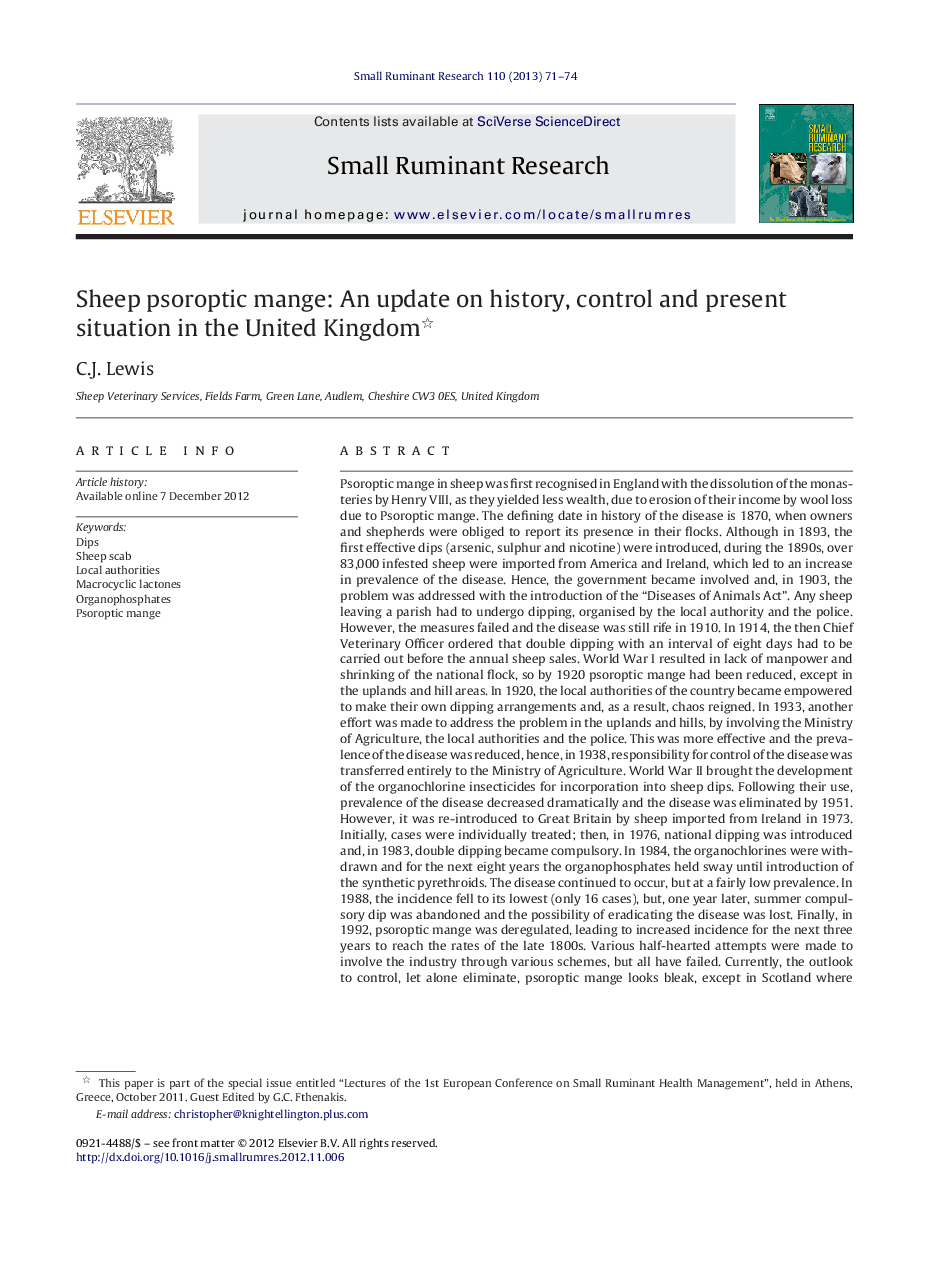| کد مقاله | کد نشریه | سال انتشار | مقاله انگلیسی | نسخه تمام متن |
|---|---|---|---|---|
| 2457117 | 1554382 | 2013 | 4 صفحه PDF | دانلود رایگان |

Psoroptic mange in sheep was first recognised in England with the dissolution of the monasteries by Henry VIII, as they yielded less wealth, due to erosion of their income by wool loss due to Psoroptic mange. The defining date in history of the disease is 1870, when owners and shepherds were obliged to report its presence in their flocks. Although in 1893, the first effective dips (arsenic, sulphur and nicotine) were introduced, during the 1890s, over 83,000 infested sheep were imported from America and Ireland, which led to an increase in prevalence of the disease. Hence, the government became involved and, in 1903, the problem was addressed with the introduction of the “Diseases of Animals Act”. Any sheep leaving a parish had to undergo dipping, organised by the local authority and the police. However, the measures failed and the disease was still rife in 1910. In 1914, the then Chief Veterinary Officer ordered that double dipping with an interval of eight days had to be carried out before the annual sheep sales. World War I resulted in lack of manpower and shrinking of the national flock, so by 1920 psoroptic mange had been reduced, except in the uplands and hill areas. In 1920, the local authorities of the country became empowered to make their own dipping arrangements and, as a result, chaos reigned. In 1933, another effort was made to address the problem in the uplands and hills, by involving the Ministry of Agriculture, the local authorities and the police. This was more effective and the prevalence of the disease was reduced, hence, in 1938, responsibility for control of the disease was transferred entirely to the Ministry of Agriculture. World War II brought the development of the organochlorine insecticides for incorporation into sheep dips. Following their use, prevalence of the disease decreased dramatically and the disease was eliminated by 1951. However, it was re-introduced to Great Britain by sheep imported from Ireland in 1973. Initially, cases were individually treated; then, in 1976, national dipping was introduced and, in 1983, double dipping became compulsory. In 1984, the organochlorines were withdrawn and for the next eight years the organophosphates held sway until introduction of the synthetic pyrethroids. The disease continued to occur, but at a fairly low prevalence. In 1988, the incidence fell to its lowest (only 16 cases), but, one year later, summer compulsory dip was abandoned and the possibility of eradicating the disease was lost. Finally, in 1992, psoroptic mange was deregulated, leading to increased incidence for the next three years to reach the rates of the late 1800s. Various half-hearted attempts were made to involve the industry through various schemes, but all have failed. Currently, the outlook to control, let alone eliminate, psoroptic mange looks bleak, except in Scotland where psoroptic mange is once again a notifiable disease. The early dips were partially successful in treating, but not eliminating psoroptic mange. Introduction of the organochlorines and organophosphates rectified the situation, but the disease had spread widely and problems of complete treatment and failure of some shepherds to take the problem seriously, failed to make full use of their efficacy. Macrocyclic lactones provide an easy control option, but they are not 100% effective, they have confusing directions for use and long withdrawal periods and they pose the danger of resistance development by internal parasites as a consequence of continuous use. Currently, the only available products with 100% efficacy are the organophosphates, which, however, are under threat, because of a perceived potential threat to humans; moreover, they have long withdrawal periods. Research studies into biological control and vaccination have not yielded any useful results. Hopefully, the return to notifiable disease status in Scotland will be successful and act as an incentive for a similar approach to be made in the rest of Great Britain.
Journal: Small Ruminant Research - Volume 110, Issues 2–3, March 2013, Pages 71–74